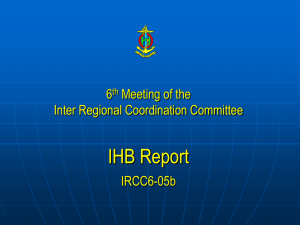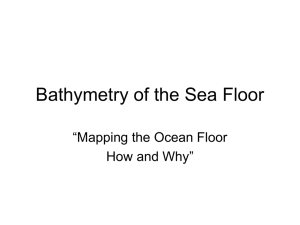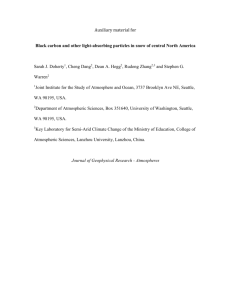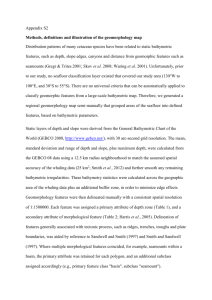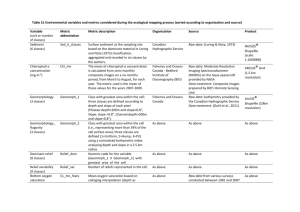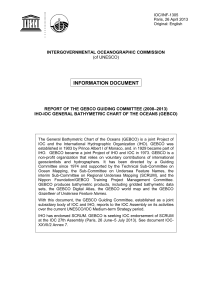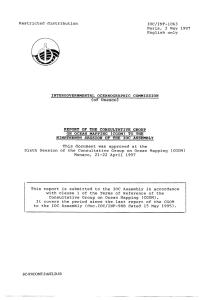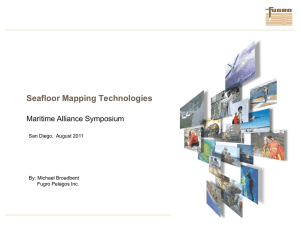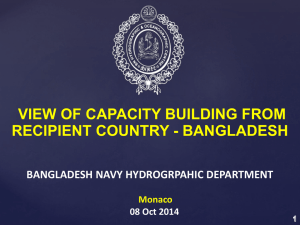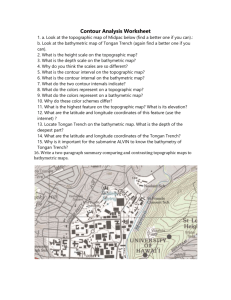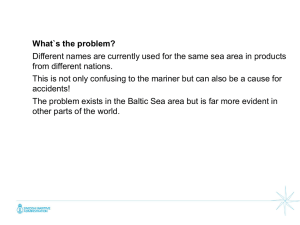GGC - International Hydrographic Organization
advertisement
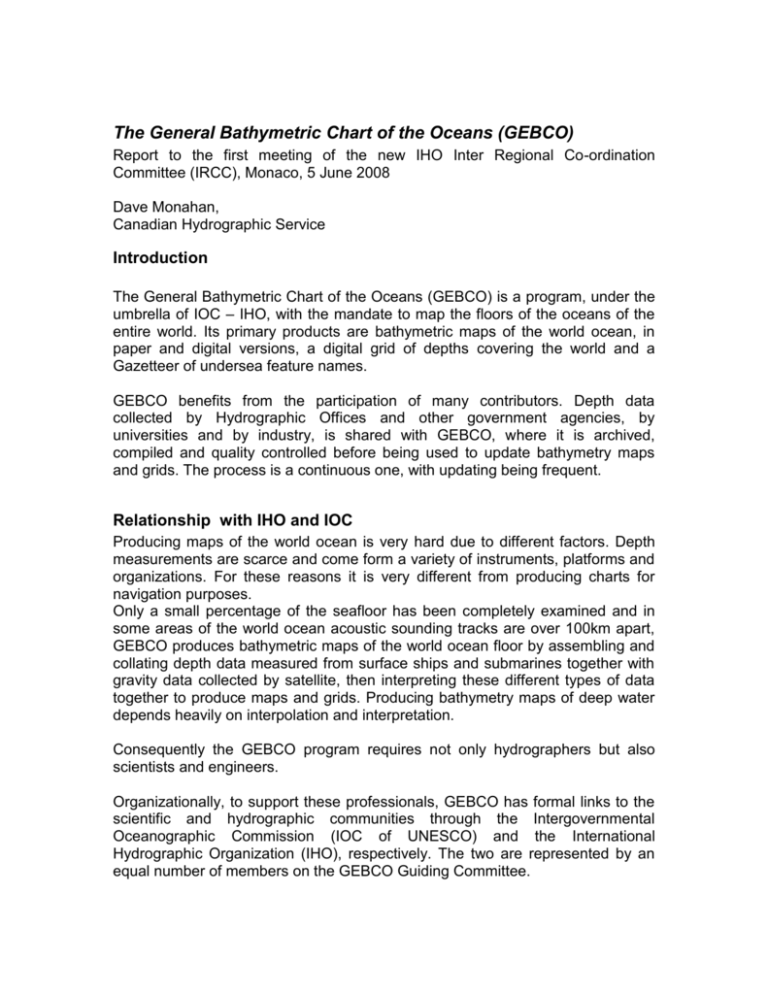
The General Bathymetric Chart of the Oceans (GEBCO) Report to the first meeting of the new IHO Inter Regional Co-ordination Committee (IRCC), Monaco, 5 June 2008 Dave Monahan, Canadian Hydrographic Service Introduction The General Bathymetric Chart of the Oceans (GEBCO) is a program, under the umbrella of IOC – IHO, with the mandate to map the floors of the oceans of the entire world. Its primary products are bathymetric maps of the world ocean, in paper and digital versions, a digital grid of depths covering the world and a Gazetteer of undersea feature names. GEBCO benefits from the participation of many contributors. Depth data collected by Hydrographic Offices and other government agencies, by universities and by industry, is shared with GEBCO, where it is archived, compiled and quality controlled before being used to update bathymetry maps and grids. The process is a continuous one, with updating being frequent. Relationship with IHO and IOC Producing maps of the world ocean is very hard due to different factors. Depth measurements are scarce and come form a variety of instruments, platforms and organizations. For these reasons it is very different from producing charts for navigation purposes. Only a small percentage of the seafloor has been completely examined and in some areas of the world ocean acoustic sounding tracks are over 100km apart, GEBCO produces bathymetric maps of the world ocean floor by assembling and collating depth data measured from surface ships and submarines together with gravity data collected by satellite, then interpreting these different types of data together to produce maps and grids. Producing bathymetry maps of deep water depends heavily on interpolation and interpretation. Consequently the GEBCO program requires not only hydrographers but also scientists and engineers. Organizationally, to support these professionals, GEBCO has formal links to the scientific and hydrographic communities through the Intergovernmental Oceanographic Commission (IOC of UNESCO) and the International Hydrographic Organization (IHO), respectively. The two are represented by an equal number of members on the GEBCO Guiding Committee. Much more important than any formal links to International organizations is the informal and very effective network of GEBCO participants and the professional colleagues and organizations that they have access to. GEBCO participants are employed in national laboratories, university research and teaching departments, navies and coast guards, and private industry. Products GEBCO’s most recent paper production is a new bathymetric map of the world, suitable for general audiences as well as specialists. Digitally, the regular grid of depth data covering the entire ocean is regularly updated and downloadable from the GEBCO website. The grid will soon be replaced with one using a finer spacing between grid nodes. GEBCO also compile a Gazetteer of undersea feature names through its subcommittee (SCUFN) that evaluates and authorizes new undersea feature names. The Gazetteer is published by the International Hydrographic Organization. Feature names are a fundamental part of being able to describe the seafloor Capacity Building To build capacity to create bathymetry maps in countries generally lacking such human resources, in 2004 GEBCO united with the Nippon Foundation to form the Nippon Foundation GEBCO Training Project. In this program, graduate-level scientists and hydrographers spend one full year at the Center for Coastal and Ocean Mapping /Joint Hydrographic Center at the University of New Hampshire, USA, where they are trained in the production of bathymetry maps. The course consists of graduate level classes, practical laboratory exercises, a month long field course, and assignments to another mapping organization and to a mapping cruise. Twenty four students have completed the course, six are currently enrolled and another six will commence studies in August. HOs have participated by sending valuable staff members as students (of the 36 students, 25 are staff of national HOs) and by occasionally hosting students during their work assignments. Future directions A. Full integration of the Nippon Foundation program graduates into the GEBCO network. It is hoped that the graduates will participate fully in GEBCO, becoming members of committees and Working Groups, and eventually taking over the responsibilities of senior GEBCO members. Graduates will be supported to produce a map of the seafloor near their home country. Doing so will frequently require working with neighboring countries to demonstrate techniques learned during the teaching program and to obtain data in adjacent areas. The fully trained Nippon Foundation Scholars will be able to extend and apply their knowledge through teaching, demonstrating and explaining the importance of bathymetric mapping. Each area to be mapped would be overseen by a GEBCO Project Group that includes scientists and hydrographers from local states. B. Google Earth Bathymetry appeared on Google Earth in January. It included credits to GEBCO, and to several other organizations. Although GEBCO had had some meetings with Google about bathymetry, the bathymetry that appeared on GE was in fact a poorly executed mix from several sources. Negotiations with Google are continuing with the aim of having GEBCO, and its updates, as the source of bathymetry in Google Earth. We think that Google Earth could be a good opportunity to show bathymetric maps to common people and to give them the possibility to know GEBCO project and, in general, the activities of IHO and IOC. Last but not the least, it could be an opportunity to receive some revenue. Another opportunity could be offer by a very big company (Nokia) that asks for the possibility to use GEBCO tools in their products. This is a new chance and, at the moment, there are only informal contacts. Proposals To Improve Overall Inter Regional Coordination Support for IBCs In some areas of the world, regional mapping projects are undertaken, usually with IOC support and sometimes with IHO support. The maps resulting from these projects are valuable in their own right, meeting the needs of users for seafloor maps. HOs within the map area can play a strong role as leaders and organizers, data providers, and cartographic experts. They can coordinate with each other the production and data flow, and going as far as to provide the geospatial infrastructure for the project. IBCs can be projects on which RHCs can focus and produce a tangible result demonstrable to others. Support for sending data to IHO Data Center for Digital Bathymetry (IHO DCDB) HOs that have access to depths deeper than normal navigation depths can greatly assist GEBCO mapping the entire ocean by ensuring that the deep data is passed to the IHO DCDB. Data that HOs collect themselves is routinely passed to the Data Center, and this valuable data can in some cases be amplified by encouraging other organizations within the HO’s sphere of influence to do the same. UNCLOS Many HOs are involved with their State’s preparation of juridical Continental Shelf mapping under Article 76 of UNCLOS. In some cases, neighboring Coastal States are cooperating in data collection. The data being collected, primarily over Continental Slopes, is usually the newest and most detailed in the area. Once the Coastal State’s submission to the UN has been dealt with to its satisfaction, HOs can contribute greatly to mapping the world ocean by having the Article 76 data sent to the IHO DCDB.
